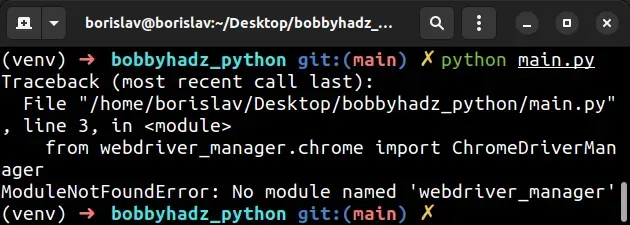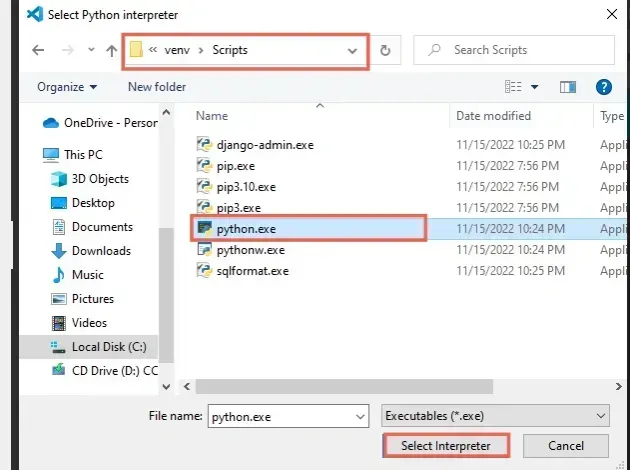ModuleNotFoundError: No module named 'selenium' in Python
Last updated: Apr 8, 2024
Reading time·7 min

# ModuleNotFoundError: No module named 'selenium' in Python
The Python "ModuleNotFoundError: No module named 'selenium'" occurs when we
forget to install the selenium module before importing it or install it in an
incorrect environment.
To solve the error, install the module by running the pip install selenium
command.

Open your terminal in your project's root directory and install the selenium
module.
# 👇️ In a virtual environment or using Python 2 pip install selenium # 👇️ For Python 3 (could also be pip3.10 depending on your version) pip3 install selenium # 👇️ If you get a permissions error sudo pip3 install selenium pip install selenium --user # 👇️ If you don't have pip in your PATH environment variable python -m pip install selenium # 👇️ For Python 3 (could also be pip3.10 depending on your version) python3 -m pip install selenium # 👇️ Using py alias (Windows) py -m pip install selenium # 👇️ For Anaconda conda install -c conda-forge selenium # 👇️ For Jupyter Notebook !pip install selenium
After you install the selenium package, try importing it as follows.
from selenium import webdriver driver = webdriver.Chrome() driver.get("http://www.python.org") driver.close()
If you get an error that the executable needs to be in PATH, you have to install the webdriver-manager module.
# 👇️ In a virtual environment or using Python 2 pip install webdriver-manager # 👇️ For Python 3 (could also be pip3.10 depending on your version) pip3 install webdriver-manager # 👇️ If you get a permissions error sudo pip3 install webdriver-manager pip install webdriver-manager --user # 👇️ If you don't have pip in your PATH environment variable python -m pip install webdriver-manager # 👇️ For Python 3 (could also be pip3.10 depending on your version) python3 -m pip install webdriver-manager # 👇️ Using py alias (Windows) py -m pip install webdriver-manager # 👇️ For Anaconda conda install -c conda-forge webdriver-manager # 👇️ For Jupyter Notebook !pip install webdriver-manager
If you get the error "ModuleNotFoundError: No module named 'webdriver_manager'",
then you haven't installed the webdriver-manager package in the environment.

You can view the import statement for using the webdriver-manager module with
each browser in the
official pypi page. Here is an
example that uses chrome:
from selenium import webdriver from selenium.webdriver.chrome.service import Service from webdriver_manager.chrome import ChromeDriverManager driver = webdriver.Chrome(service=Service(ChromeDriverManager().install())) driver.get("http://www.python.org") driver.close()
The error occurs for multiple reasons:
- Not having the
seleniumpackage installed by runningpip install selenium. - Installing the package in a different Python version than the one you're using.
- Installing the package globally and not in your virtual environment.
- Your IDE running an incorrect version of Python.
- Naming your module
selenium.pywhich would shadow the official module. - Declaring a variable named
seleniumwhich would shadow the imported variable.
If the error persists, get your Python version and make sure you are installing the package using the correct Python version.
python --version

For example, my Python version is 3.10.4, so I would install the selenium
package with pip3.10 install selenium.
pip3.10 install selenium # 👇️ If you get a permissions error use pip3 (NOT pip3.X) sudo pip3 install selenium
Notice that the version number corresponds to the version of pip I'm using.
If the PATH for pip is not set up on your machine, replace pip with
python3 -m pip:
# 👇️ Make sure to use your version of Python, e.g. 3.10 python3 -m pip install selenium
If the error persists, try restarting your IDE and development server/script.
# Check if the package is installed
You can
check if you have the selenium package installed
by running the pip show selenium command.
# 👇️ Check if you have selenium installed pip show selenium # 👇️ If you don't have pip set up in PATH python -m pip show selenium
The pip show selenium command will either state that the package is not
installed or show a bunch of information about the package, including the
location where the package is installed.
# Make sure your IDE is using the correct Python version
If the package is not installed, make sure your IDE is using the correct version of Python.
selenium package using the incorrect version or your IDE might be set up to use a different version.For example, In VSCode, you can press CTRL + Shift + P or (⌘ + Shift + P
on Mac) to open the command palette.
Then type "Python select interpreter" in the field.

Then Select the correct Python version from the dropdown menu.

# Install the package in a Virtual Environment
If you are using a virtual environment, make sure you are installing selenium
in your virtual environment and not globally.
You can try creating a virtual environment if you don't already have one.
# 👇️ Use the correct version of Python when creating VENV python3 -m venv venv # 👇️ Activate on Unix or MacOS source venv/bin/activate # 👇️ Activate on Windows (cmd.exe) venv\Scripts\activate.bat # 👇️ Activate on Windows (PowerShell) venv\Scripts\Activate.ps1 # 👇️ Install selenium in your virtual environment pip install selenium
If the python3 -m venv venv command doesn't work, try the following 2
commands:
python -m venv venvpy -m venv venv
Your virtual environment will use the version of Python that was used to create it.
selenium.py because that would shadow the original selenium module.You also shouldn't be declaring a variable named selenium as that would also
shadow the original module.
# Try reinstalling the package
If the error is not resolved, try to uninstall the selenium package and then
reinstall it.
# 👇️ Check if you have selenium installed pip show selenium # 👇️ If you don't have pip set up in PATH python -m pip show selenium # 👇️ Uninstall selenium pip uninstall selenium # 👇️ If you don't have pip set up in PATH python -m pip uninstall selenium # 👇️ Install selenium pip install selenium # 👇️ If you don't have pip set up in PATH python -m pip install selenium
Try restarting your IDE and development server/script.
You can also try to upgrade the version of the selenium package.
pip install selenium --upgrade # 👇️ If you don't have pip set up in PATH python -m pip install selenium --upgrade
# Import "selenium" could not be resolved from source Pylance
The error "Import "selenium" could not be resolved from source Pylance" occurs
when the selenium module is not installed or you have selected the incorrect
Python interpreter in your IDE (e.g. Visual Studio Code).
To solve the error, install selenium and select the correct Python interpreter
in your IDE.

Import "selenium" could not be resolved from source Pylance(reportMissingModuleSource) [Ln 1, Col 8]
# Make sure the correct Python interpreter is selected in your IDE
If you have multiple Python versions installed on your machine, you might have
installed the selenium package using the incorrect version or your IDE might
be set up to use a different version.
For example, In Visual Studio Code you can:
- Press
CTRL + Shift + Por (⌘+Shift+Pon macOS) to open the command palette.
Then type "Python select interpreter" in the search field.

- Select the correct Python version from the dropdown menu.

If the error persists, try restarting your IDE and development server/script. VSCode often glitches and a reboot resolves the issue.
If the error is not resolved, try to use the Visual Studio Code terminal to
install the selenium module.
You can press CTRL + ` (Backtick) on your keyboard to open the Visual Studio code terminal.
CTRL+Shift+P and then type "View: Toggle Terminal".
Once you open the terminal, Visual Studio Code will automatically activate your virtual environment (if you have one).
Run the pip install selenium command.
pip install selenium
If the error persists, try to select the Python interpreter by specifying the path:
- Press
CTRL + Shift + Por (⌘+Shift+Pon Mac) to open the command palette. - Type "Python select interpreter" in the field.

- Select "Enter interpreter path...".

- Click on "Find".

- In the window that opens, navigate to your Python executable:
- If you have a virtual environment on Windows, click on your
venvfolder, then double-click on theScriptsfolder, select thepython.exefile and then Select interpreter.

- If you have a virtual environment on macOS or Linux, click on your
venvfolder, then double-click on thebinfolder, select thepythonfile and then Select interpreter.

- If you don't have a virtual environment, use one of the following commands to
get your path to your
python.exeorpythonexecutable, specify the path to the file and select the executable.
where python python -c "import sys; print(sys.executable)"

If the error persists, try restarting your IDE and development server/script.
# Alternatively, use a comment to disable the warning
If none of the suggestions helped, you can use a comment to disable the Pylance warning in your IDE.
import selenium # type: ignore print(selenium)
You simply have to add the # type: ignore command on the same line as the
import statement to disable the check for the specific import.

